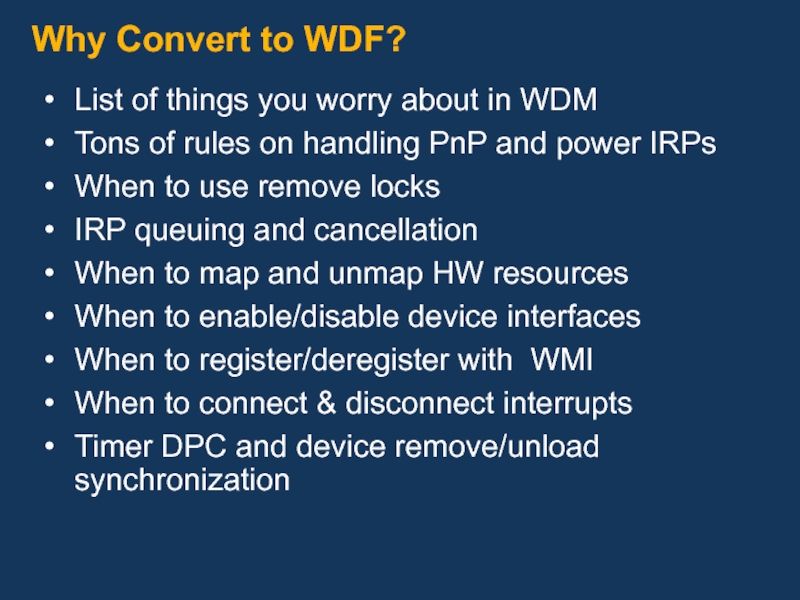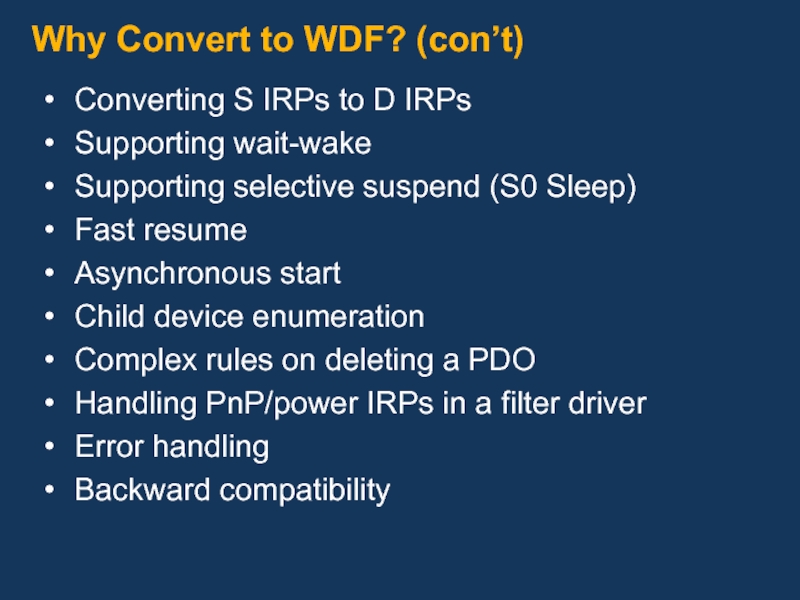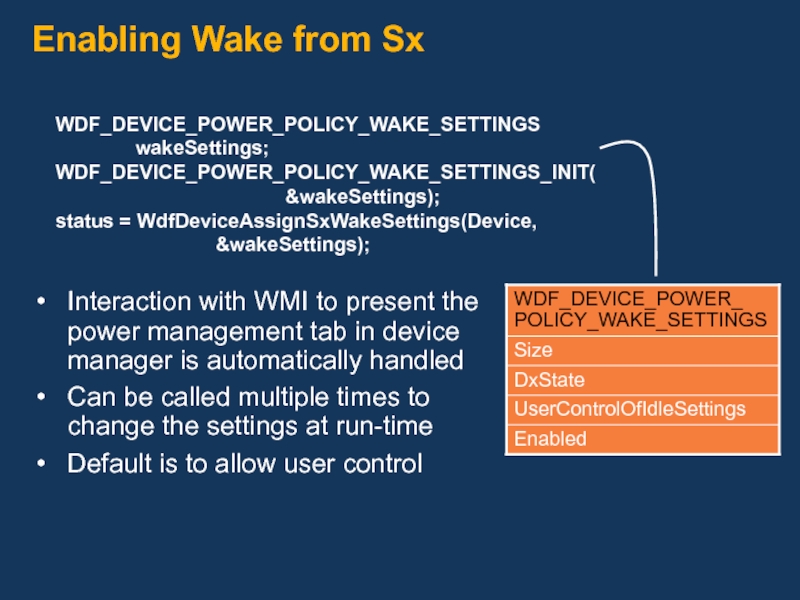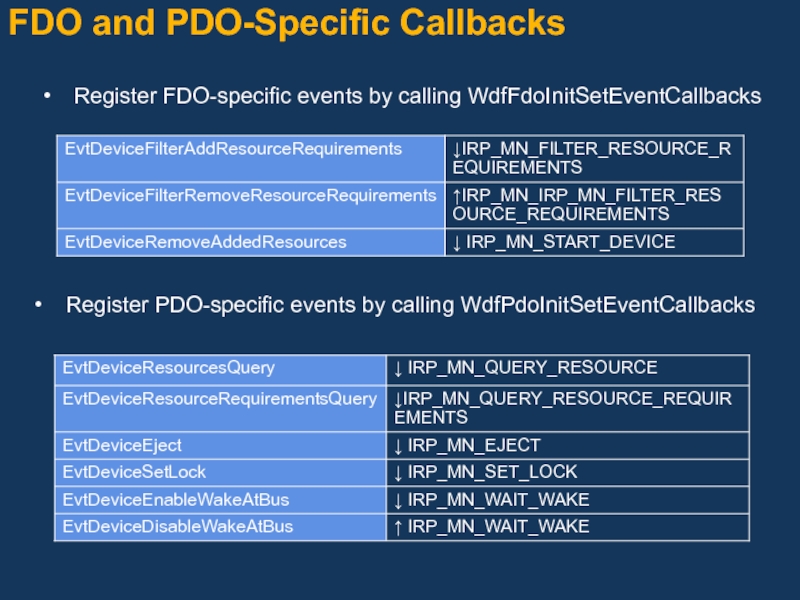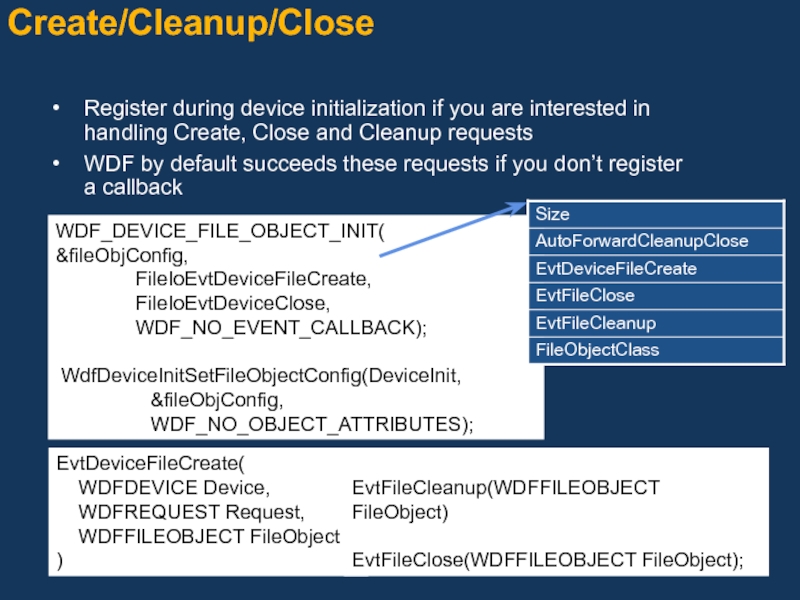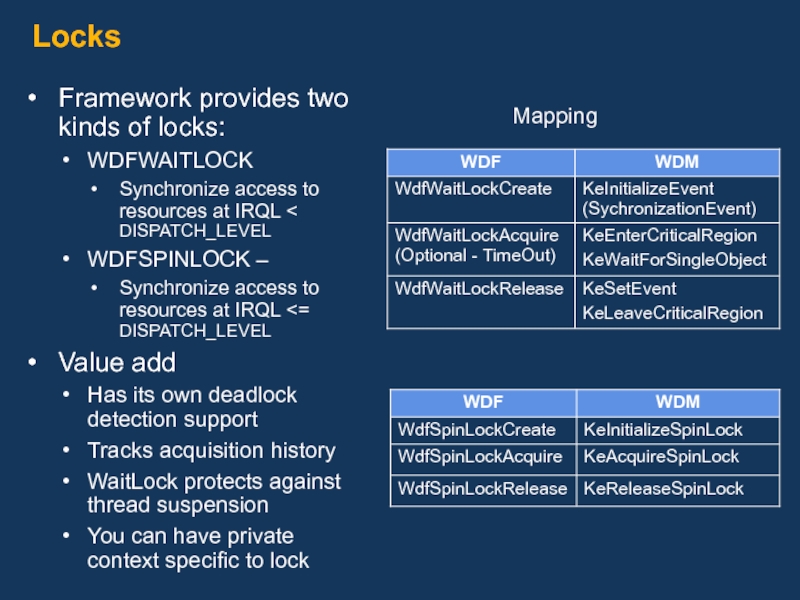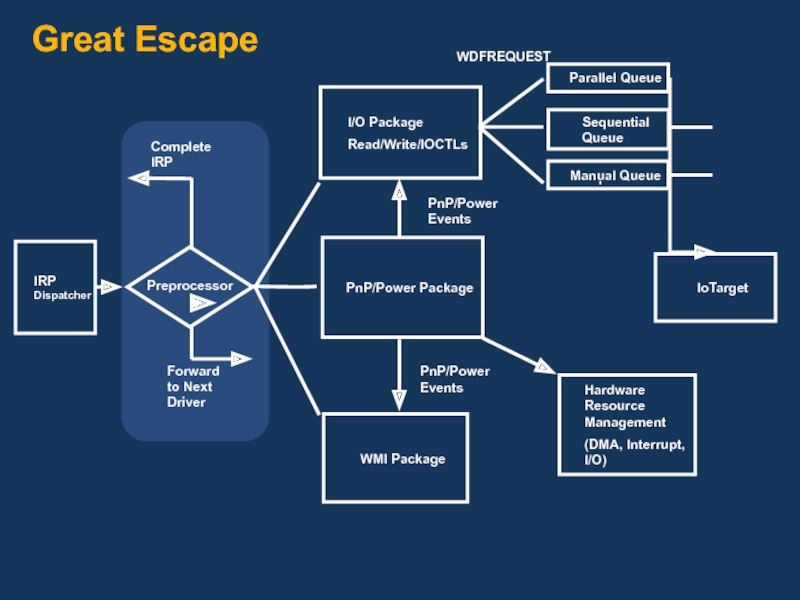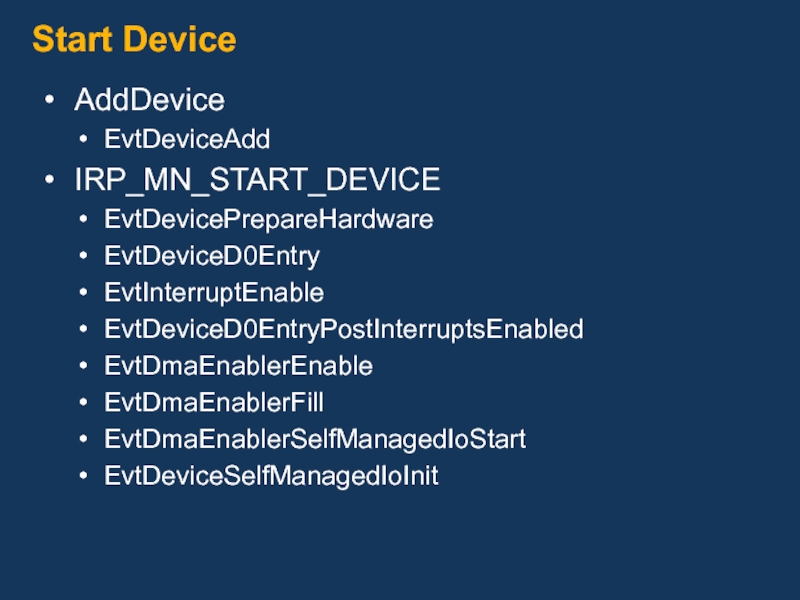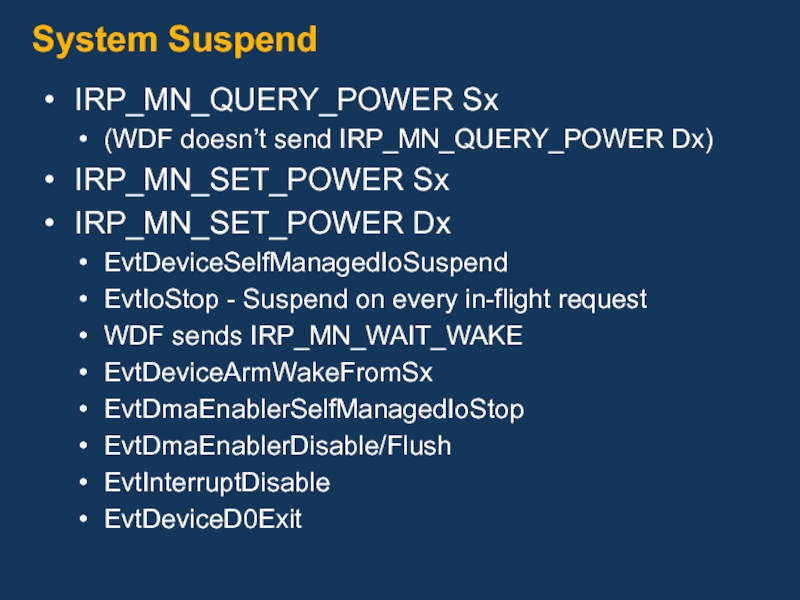- Главная
- Разное
- Дизайн
- Бизнес и предпринимательство
- Аналитика
- Образование
- Развлечения
- Красота и здоровье
- Финансы
- Государство
- Путешествия
- Спорт
- Недвижимость
- Армия
- Графика
- Культурология
- Еда и кулинария
- Лингвистика
- Английский язык
- Астрономия
- Алгебра
- Биология
- География
- Детские презентации
- Информатика
- История
- Литература
- Маркетинг
- Математика
- Медицина
- Менеджмент
- Музыка
- МХК
- Немецкий язык
- ОБЖ
- Обществознание
- Окружающий мир
- Педагогика
- Русский язык
- Технология
- Физика
- Философия
- Химия
- Шаблоны, картинки для презентаций
- Экология
- Экономика
- Юриспруденция
How to Port WDM Driver to KMDF презентация
Содержание
- 1. How to Port WDM Driver to KMDF
- 2. Agenda Introduction to WDF Why should I
- 3. Agenda (con’t) Different types of queues How
- 4. What is WDF? Windows Driver Foundation consists
- 5. Why Convert to WDF? List of things
- 6. Why Convert to WDF? (con’t) Converting S
- 7. Case Study: PCIDRV Sample This sample is
- 8. Case Study: Serial Sample WDF sample does
- 9. Case Study: OSRUSBFX2 Sample The WDM version
- 10. Object Model Objects are the basis of
- 11. Creating an Object (Abc)
- 12. Object Relationship WDFDEVICE WDFINTERRUPT WDFIOTARGET
- 13. Deleting an Object WdfObjectDelete() - single delete
- 14. Mapping – WDF Objects to WDM
- 15. Naming Pattern Methods: Status = WdfDeviceCreate(); Properties:
- 16. DriverEntry – WDM Called when the driver
- 17. DriverEntry – WDF DriverEntry is called when
- 18. PnP/Power Stage IRP Dispatcher Pnp/Power Package
- 19. AddDevice – WDM ToasterAddDevice( IN
- 20. PnP/Power Boilerplate – WDM
- 21. PnP/Power – WDF WDF requires that you
- 22. EvtDeviceAdd – Software Driver NTSTATUS ToasterEvtDeviceAdd(
- 23. EvtDeviceAdd – Filter Driver NTSTATUS FilterEvtDeviceAdd(
- 24. EvtDeviceAdd – Hardware Driver NTSTATUS EvtDeviceAdd(
- 25. PnP/Power Callbacks EvtDevicePrepareHardware One time initialization, first
- 26. Mapping – WDF Callbacks to WDM IRPs
- 27. Self Managed I/O Drivers may want to
- 28. Self Managed I/O – Mapping PCIDRV sample
- 29. Power Policy Owner Default rules on power
- 30. Enabling Wake from Sx WDF_DEVICE_POWER_POLICY_WAKE_SETTINGS wakeSettings; WDF_DEVICE_POWER_POLICY_WAKE_SETTINGS_INIT(
- 31. Idle-Time Power Management – S0 You can
- 32. Power Policy Event Callbacks WDF_POWER_POLICY_EVENT_CALLBACKS powerPolicyCallbacks;
- 33. Mapping – Wake Callbacks to Power IRPs
- 34. Interrupts NTSTATUS EvtDeviceAdd( ) { …
- 35. FDO and PDO-Specific Callbacks Register FDO-specific events
- 36. Summary - Callback Order WDF
- 37. Start/Power Up Path EvtDeviceRemoveAddedResources EvtPrepareHardware EvtDeviceD0Entry(DState)
- 38. Remove/Surprise-Remove/Stop/ Power-Down Path YES NO
- 39. I/O Stage IRP Dispatcher PnP/Power Package
- 40. Queues Queue object is used to present
- 41. Creating a Queue NTSTATUS EvtDeviceAdd(
- 42. WDFQUEUE Events EvtIoDefault – Called for any
- 43. Default Queue Pnp/Power Events I/O Package
- 44. Preconfigured Queue PnP/Power Events I/O Package
- 45. Multiple queues Manually forward requests by calling WdfRequestForwardToIoQueue
- 46. Queue State For non-power managed queue, driver
- 47. DDIs for Changing Queue States
- 48. Power Managed Queue Accepting
- 49. Create/Cleanup/Close Register during device initialization if you
- 50. Create/Close/Cleanup Create request You can pend, forward
- 51. Request Cancellation Requests waiting in the queue
- 52. Read/Write/IOCTL Callbacks VOID EvtIoRead( IN
- 53. Request Buffers Getting input buffer WdfRequestRetrieveInputBuffer WdfRequestRetrieveInputMemory
- 54. Retrieve Buffer of Read Request Calling WdfRequestRetrieveInputXxx functions on Read request will return STATUS_INVALID_DEVICE_REQUEST error.
- 55. Retrieve Buffer of Write Request Calling WdfRequestRetrieveOutputXxx functions on Write request will return STATUS_INVALID_DEVICE_REQUEST error
- 56. Retrieve Buffers of IOCTL Request
- 57. Retrieve Buffers of IOCTL Request (con’t)
- 58. METHOD_NEITHER Requests To handle this type of
- 59. Timer/DPC/Work Item Value add Allows
- 60. DPC NTSTATUS EvtDeviceAdd( ) { …
- 61. Timer NTSTATUS EvtDeviceAdd( ) { …
- 62. Work Item NTSTATUS EvtDeviceAdd( ) {
- 63. Locks Framework provides two kinds of locks:
- 64. Synchronization Scope & Execution Level WdfExecutionLevelPassive
- 65. Sample Scenario – Serial DriverEntry() {
- 66. Synchronization Scope & Execution Level - Summary
- 67. I/O Target IRP Dispatcher PnP/Power Package
- 68. Sending Request - I/O Target What is
- 69. Default I/O Target WdfDeviceGetIoTarget returns WDFIOTARGET for
- 70. Remote I/O Target Remote I/O target represents
- 71. Send Your Own Request - Synchronous IoBuildSynchronousFsdRequest
- 72. Send Your Own Request - Synchronous Buffers
- 73. Roll Your Own Request- Asynchronous IoBuildAsynchronousFsdRequest maps
- 74. Send Your Own Request - Asynchronous status
- 75. Escape to WDM Converting to WDF is
- 76. Great Escape IRP Dispatcher WDFREQUEST
- 77. Great Escape – Sample Code EvtDeviceAdd() {
- 78. Call to Action Work together with us
- 79. Reference Slides
- 80. Sample Scenarios – Callback Order Following slides
- 81. Start Device AddDevice EvtDeviceAdd IRP_MN_START_DEVICE EvtDevicePrepareHardware EvtDeviceD0Entry EvtInterruptEnable EvtDeviceD0EntryPostInterruptsEnabled EvtDmaEnablerEnable EvtDmaEnablerFill EvtDmaEnablerSelfManagedIoStart EvtDeviceSelfManagedIoInit
- 82. Disable or Uninstall Device IRP_MN_QUERY_REMOVE_DEVICE EvtDeviceQueryRemove IRP_MN_REMOVE_DEVICE
- 83. Surprise Remove Device IRP_MN_SURPRISE_REMOVAL EvtDeviceSurpriseRemoval EvtDeviceSelfManagedIoSuspend
- 84. Resource Rebalance IRP_MN_QUERY_STOP_DEVICE EvtDeviceQueryStop IRP_MN_STOP_DEVICE EvtDeviceSelfManagedIoSuspend EvtIoStop
- 85. Failed Remove or Stop Failed Remove IRP_MN_QUERY_REMOVE_DEVICE EvtDeviceQueryRemove IRP_MN_CANCEL_REMOVE_DEVICE Failed Stop: IRP_MN_QUERY_STOP_DEVICE EvtDeviceQueryStop IRP_MN_CANCEL_STOP_DEVICE
- 86. System Suspend IRP_MN_QUERY_POWER Sx (WDF doesn’t send
- 87. System Resume System sends IRP_MN_SET_POWER S0 WDF
- 88. Parsing HW Resources NTSTATUS PciDrvEvtDevicePrepareHardware (
- 89. © 2005 Microsoft Corporation. All rights reserved.
Слайд 2Agenda
Introduction to WDF
Why should I convert to KMDF: Case Study
Basic object
DriverEntry
PnP/Power callbacks
Self-Managed I/O callbacks
How to configure wait-wake & idle power management
Interrupt handling
Callbacks specific to FDO and PDO
Order of callbacks with respect to PnP/Power actions
Слайд 3Agenda (con’t)
Different types of queues
How queue states are managed by WDF
Request
Handling Create, Cleanup & Close requests
Handling I/O requests – Read/Write/Ioctl
Timers/DPC/Work items
Locks: WaitLock, Spinlock
Automatic I/O synchronization
Sending request to another driver
Escaping to WDM
Слайд 4What is WDF?
Windows Driver Foundation consists of
User Mode Driver Framework (UMDF
Kernel Mode Driver Framework (KMDF)
Tools: SDV, Driver PREfast, DIG, etc.
KMDF is built on top of WDM
Drivers written using KMDF are compatible from Windows 2000 forward
Drivers are written using objects
Слайд 5Why Convert to WDF?
List of things you worry about in WDM
Tons
When to use remove locks
IRP queuing and cancellation
When to map and unmap HW resources
When to enable/disable device interfaces
When to register/deregister with WMI
When to connect & disconnect interrupts
Timer DPC and device remove/unload synchronization
Слайд 6Why Convert to WDF? (con’t)
Converting S IRPs to D IRPs
Supporting wait-wake
Supporting
Fast resume
Asynchronous start
Child device enumeration
Complex rules on deleting a PDO
Handling PnP/power IRPs in a filter driver
Error handling
Backward compatibility
Слайд 7Case Study: PCIDRV Sample
This sample is written for the Intel E100B
It’s a WDM version of network driver with NDIS interfaces separated out in an upper filter driver (ndisedge)
Both samples are in the DDK and are functionally equivalent
Слайд 8Case Study: Serial Sample
WDF sample does not support multi-port serial
(WDM
WDM statistics exclude multi-port support serial code
Слайд 9Case Study: OSRUSBFX2 Sample
The WDM version of OSRUSBFx2 sample (available on
Слайд 10Object Model
Objects are the basis of WDF
Everything in framework is represented
Objects have properties, methods, and events
WDF functions that operate on object
Calls made by WDF into the driver to
notify something
Methods that get or set a single value
Have one or more driver owned context memory areas
Lifetime of the object is controlled by reference counts
Organized hierarchically for controlling object life time
Not an inheritance based hierarchy
Driver references objects as handles, not pointers
Слайд 11Creating an Object (Abc)
Header File:
Struct _ABC_CONTEXT {
…
} ABC_CONTEXT *PABC_CONTEXT
WDF_DECLARE_CONTEXT_TYPE_WITH_NAME(
ABC_CONTEXT,
Source File:
WDF_OBJECT_ATTRIBUTES_INIT(&Attributes);
WDF_OBJECT_ATTRIBUTES_SET_CONTEXT_TYPE(
&Attributes, ABC_CONTEXT );
Attributes.EvtCleanupCallback = AbcEvtCleanup;
Attributes.EvtDestroyCallback = AbcEvtDestroy;
WDF_ABC_CONFIG_INIT( &Config );
WdfAbcCreate( &Attributes,
&Config, &Handle )
Context = GetAbcContext( Handle );
InheritParentPassive Dispatch
InheritParentDevice Object None
Слайд 12Object Relationship
WDFDEVICE
WDFINTERRUPT
WDFIOTARGET
WDFCHILDLIST
WDFFILEOBJECT WDFREQUEST – queue delivered
WDFTRANSACTION WDFCOMMONBUFFER
WDFWMIPROVIDER
WDFQUEUE
WDFDRIVER
WDFWMIINSTANCE
WDFDMAENABLER
WDFCOLLECTION WDFLOOKASIDE WDFKEY WDFWAITLOCK
WDFDPC WDFTIMER WDFWORKITEM
WDFUSBDEVICE
WDFUSBPIPE
Слайд 13Deleting an Object
WdfObjectDelete() - single delete function to delete all types
Child objects will be deleted when their parent is deleted
Some objects cannot be deleted by the driver because the lifetime is controlled by WDF
WDFDRIVER
WDFDEVICE for FDO and PDO
WDFFILEOBJECT
WDFREQUEST
Etc.
Слайд 15Naming Pattern
Methods:
Status = WdfDeviceCreate();
Properties:
Cannot fail
WdfInterruptGetDevice();
WdfInterruptSetPolicy();
Can fail:
Status = WdfRegistryAssignValue();
Status = WdfRegistryQueryValue();
Status
Callbacks:
PFN_WDF_INTERRUPT_ENABLE EvtInterruptEnable
Init Macros:
WDF_XXX_CONFIG_INIT
WDF_XXX_EVENT_CALLBACKS_INIT
Object
Operation
Слайд 16DriverEntry – WDM
Called when the driver is first loaded in memory
Sets
NTSTATUS
DriverEntry(
IN PDRIVER_OBJECT DriverObject
IN PUNICODE_STRING RegistryPath
)
{
DriverObject->DriverExtension->AddDevice = AddDevice;
DriverObject->MajorFunction[IRP_MJ_PNP] = DispatchPnp;
DriverObject->MajorFunction[IRP_MJ_POWER] = DispatchPower;
DriverObject->MajorFunction[IRP_MJ_SYSTEM_CONTROL] = DispatchSysControl;
….
return STATUS_SUCCESS;
}
Слайд 17DriverEntry – WDF
DriverEntry is called when the driver is first loaded
FxDriverEntry initializes the framework and calls DriverEntryv
NTSTATUS
DriverEntry(
IN PDRIVER_OBJECT DriverObject
IN PUNICODE_STRING RegistryPath
)
{
WDF_DRIVER_CONFIG_INIT( &config
ToasterEvtDeviceAdd );
status = WdfDriverCreate(
DriverObject
RegistryPath
WDF_NO_OBJECT_ATTRIBUTES
&config
WDF_NO_HANDLE
);
return STATUS_SUCCESS;
}
WdfDriverInitNonPnpDriver
WdfDriverInitNoDispatchOverride
Слайд 18
PnP/Power Stage
IRP Dispatcher
Pnp/Power Package
I/O Package
Read/Write/Ioctls/
Create/Close/Cleanup
WMI Package
Hardware Resource Management
(DMA, Interrupt, I/O)
Parallel Queue
Serial
Manual Queue
IoTarget
WDFREQUEST
Next Driver
Pnp/Power Events
Pnp/Power Events
Pnp/Power Events
IRP
Next Driver
Driver
Слайд 19AddDevice – WDM
ToasterAddDevice(
IN PDRIVER_OBJECT DriverObject,
IN PDEVICE_OBJECT PhysicalDeviceObject
{
fdoData = (PFDO_DATA) deviceObject->DeviceExtension;
fdoData->UnderlyingPDO = PhysicalDeviceObject;
deviceObject->Flags |= (DO_POWER_PAGABLE | DO_BUFFERED_IO);
fdoData->NextLowerDriver = IoAttachDeviceToDeviceStack ( );
IoRegisterDeviceInterface ( &GUID_DEVINTERFACE_TOASTER);
deviceObject->Flags &= ~DO_DEVICE_INITIALIZING;
return status;
}
Слайд 21PnP/Power – WDF
WDF requires that you register zero or more of
Rest of this talk is about how and when to register these events, and how they map to WDM irps
EvtDeviceD0Entry EvtDeviceD0Exit
EvtDevicePrepareHardware EvtDeviceReleaseHardware
EvtInterruptEnable EvtInterruptDisable
EvtDeviceD0EntryPostInterruptsDisabled EvtDeviceD0ExitPreInterrutpsDisabled
EvtDmaEnablerFill EvtDmaEnablerFlush
EvtDmaEnablerEnable EvtDmaEnablerDisable
EvtDmaEnablerSelfManagedIoStart EvtDmaEnablerSelfManagedIoStop
EvtDeviceArmWakeFromS0 EvtDeviceDisarmWakeFromS0
EvtDeviceArmWakeFromSx EvtDeviceDisarmWakeFromSx
EvtDeviceWakeFromSxTriggered EvtDeviceWakeFromS0Triggered
EvtDeviceSelfManagedIoInit EvtDeviceSelfManagedIoCleanup
EvtDeviceSelfManagedIoSuspend EvtDeviceSelfManagedIoRestart
EvtIoStop EvtIoResume
EvtDeviceQueryRemove EvtDeviceQueryStop
EvtDeviceSurpriseRemoval
Слайд 22EvtDeviceAdd – Software Driver
NTSTATUS
ToasterEvtDeviceAdd(
IN WDFDRIVER Driver
IN PWDFDEVICE_INIT
)
{
WdfDeviceInitSetIoType(DevcieInit WdfIoTypeBuffered);
WDF_OBJECT_ATTRIBUTES_INIT(&fdoAttributes);
WDF_OBJECT_ATTRIBUTES_SET_CONTEXT_TYPE(&fdoAttributes FDO_DATA);
status = WdfDeviceCreate(&DeviceInit &fdoAttributes &device);
fdoData = ToasterFdoGetData(device);
status = WdfDeviceCreateDeviceInterface(&GUID_DEVINTERFACE_TOASTER );
return status;
}
WdfDeviceInitSetIoType
WdfDeviceInitSetExclusive
WdfDeviceInitSetPowerNotPageable
WdfDeviceInitSetPowerPageable
WdfDeviceInitSetPowerInrush
WdfDeviceInitSetDeviceType
WdfDeviceInitAssignName
WdfDeviceInitAssignSDDLString
WdfDeviceInitSetDeviceClass
WdfDeviceInitSetCharacteristics
Слайд 23EvtDeviceAdd – Filter Driver
NTSTATUS
FilterEvtDeviceAdd(
IN WDFDRIVER Driver
IN PWDFDEVICE_INIT
)
{
WdfFdoInitSetFilter(DeviceInit);
WDF_OBJECT_ATTRIBUTES_INIT(&attributes);
WDF_OBJECT_ATTRIBUTES_SET_CONTEXT_TYPE(&attributes FILTER_DATA);
status = WdfDeviceCreate(&DeviceInit &attributes &device);
fdoData = FilterGetDeviceContext(device);
return status;
}
Слайд 24EvtDeviceAdd – Hardware Driver
NTSTATUS
EvtDeviceAdd(
IN WDFDRIVER Driver,
)
{
WdfDeviceInitSetIoType(DeviceInit, WdfDeviceIoDirect);
WDF_PNPPOWER_EVENT_CALLBACKS_INIT(&pnpPowerCallbacks);
pnpPowerCallbacks.EvtDevicePrepareHardware = EvtPrepareHardware;
pnpPowerCallbacks.EvtDeviceReleaseHardware = EvtReleaseHardware;
pnpPowerCallbacks.EvtDeviceD0Entry = EvtDeviceD0Entry;
pnpPowerCallbacks.EvtDeviceD0Exit = EvtDeviceD0Exit;
WdfDeviceInitSetPnpPowerEventCallbacks(DeviceInit, &pnpPowerCallbacks);
WDF_OBJECT_ATTRIBUTES_INIT(&fdoAttributes);
WDF_OBJECT_ATTRIBUTES_SET_CONTEXT_TYPE(&fdoAttributes, FDO_DATA);
fdoAttributes.EvtCleanupCallback = EvtDeviceContextCleanup;
status = WdfDeviceCreate(&DeviceInit, &fdoAttributes, &device);
status = NICAllocateSoftwareResources(fdoData);
….
return status;
}
WdfDeviceInitSetPnpPowerEventCallbacks
WdfDeviceInitSetPowerPolicyEventCallbacks
WdfDeviceInitSetPowerPolicyOwnership
WdfDeviceInitSetIgnoreQueryStopRemove
WdfDeviceInitRegisterPnpStateChangeCallback
WdfDeviceInitRegisterPowerStateChangeCallback
WdfDeviceInitRegisterPowerPolicyStateChangeCallback
Слайд 25PnP/Power Callbacks
EvtDevicePrepareHardware
One time initialization, first callback where device is in D0
Map
EvtDeviceReleaseHardware
One time deinitialization, called when the device is in Dx!
Unmap in memory mapped I/O, etc.
EvtDeviceD0Entry
Bring the device into D0, no interrupts connected
EvtDeviceD0Exit
Move the device into Dx, no interrupts connected
Слайд 26Mapping – WDF Callbacks to WDM IRPs
Up arrow means callback is
Down arrow means callback is invoked before forwarding the IRP
Слайд 27Self Managed I/O
Drivers may want to override automatic WDF queuing behavior
Drivers may have I/O paths that don’t pass through WDFQUEUEs (timers, DPC, etc.)
WDF provides a set of callbacks that correspond to state changes
EvtDeviceSelfManagedIoInit
EvtDeviceSelfManagedIoCleanup
EvtDeviceSelfManagedIoSuspend
EvtDeviceSelfManagedIoRestart
EvtDeviceSelfManagedIoFlush
Слайд 28Self Managed I/O – Mapping
PCIDRV sample uses Self Managed I/O callbacks
Слайд 29Power Policy Owner
Default rules on power policy ownership
Override the default by
Слайд 30Enabling Wake from Sx
WDF_DEVICE_POWER_POLICY_WAKE_SETTINGS wakeSettings;
WDF_DEVICE_POWER_POLICY_WAKE_SETTINGS_INIT(
status = WdfDeviceAssignSxWakeSettings(Device,
&wakeSettings);
Interaction with WMI to present the power management tab in device manager is automatically handled
Can be called multiple times to change the settings at run-time
Default is to allow user control
Слайд 31Idle-Time Power Management – S0
You can manually stop and resume the
WMI interaction is handled automatically
Can be called multiple times to change the settings
WDF_DEVICE_POWER_POLICY_IDLE_SETTINGS idleSettings;
WDF_DEVICE_POWER_POLICY_IDLE_SETTINGS_INIT( &idleSettings,IdleCanWakeFromS0 );
idleSettings.IdleTimeout = 10000; // 10-sec
status = WdfDeviceAssignS0IdleSettings(
WdfDevice, &idleSettings );
IdleCannotWakeFromS0
IdleCanWakeFromS0
IdleUsbSelectiveSuspend
Слайд 32Power Policy Event Callbacks
WDF_POWER_POLICY_EVENT_CALLBACKS powerPolicyCallbacks;
WDF_POWER_POLICY_EVENT_CALLBACKS_INIT(&ppc);
ppc.EvtDeviceArmWakeFromS0 = PciDrvEvtDeviceWakeArmS0;
ppc.EvtDeviceDisarmWakeFromS0 = PciDrvEvtDeviceWakeDisarmS0;
ppc.EvtDeviceWakeFromS0Triggered =
ppc.EvtDeviceArmWakeFromSx = PciDrvEvtDeviceWakeArmSx;
ppc.EvtDeviceDisarmWakeFromSx = PciDrvEvtDeviceWakeDisarmSx;
ppc.EvtDeviceWakeFromSxTriggered = PciDrvEvtDeviceWakeTriggeredSx;
WdfDeviceInitSetPowerPolicyEventCallbacks(Device, &powerPolicyCallbacks);
Слайд 34Interrupts
NTSTATUS
EvtDeviceAdd( )
{
…
WDF_INTERRUPT_CONFIG_INIT(&Config,
NICDpcForIsr);
Config.EvtInterruptEnable = NICEvtInterruptEnable;
Config.EvtInterruptDisable = NICEvtInterruptDisable;
status = WdfInterruptCreate(Device,
&Config,
WDF_NO_OBJECT_ATTRIBUTES,
&Interrupt);
}
WdfInterruptQueueDpcForIsr – to manually queue DpcForIsr
Register EvtDeviceD0EntryPostInterruptsEnabled and EvtDeviceD0ExitPreInterruptsDisabled to be called at PASSIVE_LEVEL
Слайд 35FDO and PDO-Specific Callbacks
Register FDO-specific events by calling WdfFdoInitSetEventCallbacks
Register PDO-specific events
Слайд 36Summary - Callback Order
WDF treats PnP and Power as a unified
WDF callbacks are based around primitive operations
Order in which the primitives are called is guaranteed
Next two slides show the order in which these callback are invoked for start/power-up and remove/suspend
You can see the commonalities between pnp & power operation
Слайд 37
Start/Power Up Path
EvtDeviceRemoveAddedResources
EvtPrepareHardware
EvtDeviceD0Entry(DState)
EvtInterruptEnable
EvtDeviceD0EntryPostInterruptsEnabled
EvtDmaEnablerFill/Enable
EvtDmaEnablerSelfManagedIoStart
EvtIoResume - on in-flight request
EvtDeviceSelfManagedIoRestart
EvtDeviceWakeDisarmSx or S0
EvtDeviceSelfManagedIoInit
YES
YES
NO
SUSPENDED
Were
This flow chart shows the order Device, I/O, Interrupt and DMA callbacks are invoked when the device is first started, started from stopped state due to resource rebalance or from a suspended state
DState = DX
DState = D3Final
NO
WDF
Слайд 38
Remove/Surprise-Remove/Stop/
Power-Down Path
YES
NO
EvtDmaEnablerSelfManagedIoStop
EvtDmaEnablerDisable
EvtDmaEnablerFlush
EvtDeviceD0ExitPreInterruptsDisabled
EvtInterruptDisable
EvtDeviceD0Exit(DState)
EvtDeviceArmWakeFromSx or S0
EvtReleaseHardware
EvtDeviceSelfManagedIoSuspend
EvtIoStop (Suspend) - on every in-flight
STARTED
YES
YES
YES
NO
NO
WDF
NO
Слайд 39
I/O Stage
IRP Dispatcher
PnP/Power Package
I/O Package
Read/Write/IOCTLs/
Create/Close/Cleanup
WMI Package
Hardware Resource Management
(DMA, Interrupt, I/O)
Parallel Queue
Sequential
Manual Queue
IoTarget
WDFREQUEST
Next Driver
PnP/Power Events
PnP/Power Events
PnP/Power Events
IRP
PnP/Power/WMI IRPs
Слайд 40Queues
Queue object is used to present WDFREQUEST to
the driver
Only create,
Delivery of requests is based on the queue type
Sequential: Requests are delivered one at a time
Parallel: Requests are delivered to the driver as they arrive
Manual: Driver retrieves requests from the WDQUEUE at its own pace
WDF_EXECUTION_LEVEL and WDF_SYNCHRONIZATION_SCOPE can be used to control serialization and IRQL level of those callbacks
WDFQUEUE is more than a list of pending requests!
Слайд 41Creating a Queue
NTSTATUS
EvtDeviceAdd(
IN WDFDRIVER Driver,
)
{
….
WDF_IO_QUEUE_CONFIG_INIT_DEFUALT_QUEUE( &Config,
WdfIoQueueDispatchParallel );
Config.EvtIoStart = PciDrvEvtIoStart;
Config.AllowZeroLengthRequests = TRUE;
status = WdfIoQueueCreate(
WdfDevice,
&Config,
WDF_NO_OBJECT_ATTRIBUTES,
&Queue // queue handle
);
return status;
}
typedef enum _WDF_IO_QUEUE_DISPATCH_TYPE {
WdfIoQueueDispatchSequential = 1,
WdfIoQueueDispatchParallel,
WdfIoQueueDispatchManual,
WdfIoQueueDispatchMax
} WDF_IO_QUEUE_DISPATCH_TYPE;
Слайд 42WDFQUEUE Events
EvtIoDefault – Called for any request that does not have
EvtIoRead – Called for IRP_MJ_READ requests
EvtIoWrite – Called for IRP_MJ_WRITE requests
EvtIoDeviceControl – Called for IRP_MJ_DEVICE_CONTROL
EvtIoInternalDeviceControl – Called for IRP_MJ_INTERNAL_DEVICE_CONTROL requests
EvtIoStop – Called for all inflight requests when a power down transition occurs
EvtIoResume - Called for all inflight requests when a power up transition occurs
Слайд 43Default Queue
Pnp/Power Events
I/O Package
PnP/Power
ioctl
WDFREQUESTS
Default queue receives all requests that are not
There can be only one default queue per device
Default
Parallel Queue
EvtIoDefault
Read/Write/
IOCTLs IRPS
EvtIoDeviceControl
Write & Read
WDFREQUESTS
Слайд 44Preconfigured Queue
PnP/Power Events
I/O Package
PnP/Power
Preconfigure the queue by calling WdfDeviceConfigureRequestDispatching to automatically
Default
Parallel Queue
EvtIoDefault
Read/Write/
IOCTLs IRPS
EvtIoDeviceControl
Write & Read
WDFREQUESTS
IOCTL
Parallel Queue
Слайд 46Queue State
For non-power managed queue, driver controls the state of the
Queue can be moved to any state from any state
For power managed queue, state change happens due to PnP/Power events
Queue state is determined by whether it’s accepting and dispatching requests to the driver
Queue
Dispatch
Accept
Слайд 48Power Managed Queue
Accepting - Yes Power State - OFF Dispatching -
START_DEVICE
SET_POWER (D0)
AddDevice - Created
SET_POWER (Dx)
STOP_DEVICE
REMOVE_DEVICE
SURPRISE_REMOVAL
Deleted
Purge power
managed and unmanaged queues
REMOVE_DEVICE
Accept
Power State
Dispatch
ON/OFF
Accepting - No Power State - OFF Dispatching - Yes
Accepting - Yes Power State - ON Dispatching - Yes
Слайд 49Create/Cleanup/Close
Register during device initialization if you are interested in handling Create,
WDF by default succeeds these requests if you don’t register a callback
WDF_DEVICE_FILE_OBJECT_INIT( &fileObjConfig,
FileIoEvtDeviceFileCreate,
FileIoEvtDeviceClose,
WDF_NO_EVENT_CALLBACK);
WdfDeviceInitSetFileObjectConfig(DeviceInit,
&fileObjConfig,
WDF_NO_OBJECT_ATTRIBUTES);
EvtDeviceFileCreate(
WDFDEVICE Device,
WDFREQUEST Request,
WDFFILEOBJECT FileObject
)
EvtFileCleanup(WDFFILEOBJECT FileObject)
EvtFileClose(WDFFILEOBJECT FileObject);
Слайд 50Create/Close/Cleanup
Create request
You can pend, forward it another queue, send it to
You can configure to auto-dispatch create to a specific queue
EvtIoDefault callback is invoked when a create request is dispatched by a queue
Cleanup/Close
WDF doesn’t provide a request for these events
If you send create requests down the stack, you must set the AutoForwardCleanupClose property so that WDF can forward Cleanup and Close requests
For filters, if the callbacks are not registered, WDF will auto-forward Create, Close and Cleanup
Слайд 51Request Cancellation
Requests waiting in the queue to be delivered to the
In-flight requests cannot be canceled unless explicitly made cancelable by calling
WdfRequestMarkCancelable(Request, EvtRequestCancel)
A request should be made cancelable by the driver if:
The I/O is going to take long time to complete
The I/O operation on the hardware can be stopped in mid-operation
A cancelable request must be unmarked (WdfRequestUnmarkCancelable) before completion unless it’s completed by the cancel routine
These rules are similar to WDM
Слайд 52Read/Write/IOCTL Callbacks
VOID
EvtIoRead(
IN WDFQUEUE Queue,
IN WDFREQUEST
IN size_t Length
)
VOID
EvtIoDeviceControl(
IN WDFQUEUE Queue,
IN WDFREQUEST Request,
IN size_t OutputBufferLength,
IN size_t InputBufferLength,
IN ULONG IoControlCode
)
VOID
EvtIoWrite(
IN WDFQUEUE Queue,
IN WDFREQUEST Request,
IN size_t Length
)
Слайд 53Request Buffers
Getting input buffer
WdfRequestRetrieveInputBuffer
WdfRequestRetrieveInputMemory
WdfRequestRetrieveInputWdmMdl
Getting output buffer
WdfRequestRetrieveOutputBuffer
WdfRequestRetrieveOutputMemory
WdfRequestRetrieveOutputWdmMdl
‘Input’ or ‘Output’ denotes
Input: read from memory and write to device
Output: read from device and write to memory
Слайд 54Retrieve Buffer of Read Request
Calling WdfRequestRetrieveInputXxx functions on Read request will
Слайд 55Retrieve Buffer of Write Request
Calling WdfRequestRetrieveOutputXxx functions on Write request will
Слайд 58METHOD_NEITHER Requests
To handle this type of request, you must register EvtIoInCallerContext
Callback is invoked in the calling thread context
Retrieve buffers using
WdfRequestRetrieveUnsafeUserInputBuffer
WdfRequestRetrieveUnsafeUserOutputBuffer
Lock using WdfRequestProbeAndLockUserBufferForRead/Write
Слайд 59
Timer/DPC/Work Item
Value add
Allows you to synchronize execution with the callback events
Ensures callbacks events are not invoked after the object is deleted – rundown protection
Ensures that object is not deleted until the callback has run to completion
Enables you to have private context
Слайд 60DPC
NTSTATUS
EvtDeviceAdd( )
{
…
WDF_DPC_CONFIG_INIT(&config, EvtDpc);
config.AutomaticSerialization = TRUE;
WDF_OBJECT_ATTRIBUTES_INIT(&attributes);
attributes.ParentObject = device;
status = WdfDpcCreate(&Config,
&hDpc);
}
Слайд 61Timer
NTSTATUS
EvtDeviceAdd( )
{
…
WDF_TIMER_CONFIG_INIT(&config, EvtTimer);
config.AutomaticSerialization = TRUE;
WDF_OBJECT_ATTRIBUTES_INIT(&attributes);
attributes.ParentObject = device;
status = WdfTimerCreate(&Config,
&hTimer);
}
Слайд 62Work Item
NTSTATUS
EvtDeviceAdd( )
{
…
WDF_WORKITEM_CONFIG_INIT(&config, EvtWorkItem);
config.AutomaticSerialization = TRUE;
WDF_OBJECT_ATTRIBUTES_INIT(&attributes);
attributes.ParentObject
status = WdfWorkItemCreate(&Config,
&attributes,
&hWorkItem);
}
Слайд 63Locks
Framework provides two kinds of locks:
WDFWAITLOCK
Synchronize access to resources at IRQL
WDFSPINLOCK –
Synchronize access to resources at IRQL <= DISPATCH_LEVEL
Value add
Has its own deadlock detection support
Tracks acquisition history
WaitLock protects against thread suspension
You can have private context specific to lock
Mapping
Слайд 64Synchronization Scope & Execution Level
WdfExecutionLevelPassive
Callbacks will be invoked at PASSIVE_LEVEL
Can
Creation of timer and DPC with AutomaticSerialization won’t be allowed if this attribute is set on its parent which could be device or queue
WdfSynchronizationScopeDevice
Callback events of queue, fileobject, timer, dpc, & workitem will be synchronized by a common lock
Choice of lock depends on the execution level (fast mutex or spinlock)
WdfSynchronizationScopeObject
Can be set only on queue if you want all the callbacks of a queue to be serialized with its own lock
Слайд 65Sample Scenario – Serial
DriverEntry() {
WDF_OBJECT_ATTRIBUTES_INIT(&attributes);
attributes.SynchronizationScope = WdfSynchronizationScopeDevice;
}
EvtDeviceAdd()
{
WDF_IO_QUEUE_CONFIG_INIT_DEFAULT_QUEUE(&queueConfig, Parallel);
queueConfig.EvtIoRead = SerialEvtIoRead;
queueConfig.EvtIoWrite = SerialEvtIoWrite;
WDF_OBJECT_ATTRIBUTES_INIT(&attributes);
attributes.SynchronizationScope = WdfSynchronizationScopeDevice;
status = WdfIoQueueCreate(, queueConfig,&attributes, );
WDF_OBJECT_ATTRIBUTES_INIT(&attributes);
attributes.ParentObject = Device;
WDF_TIMER_CONFIG_INIT(&timerConfig, SerialTimeoutXoff);
timerConfig.AutomaticSerialization = TRUE;
status = WdfTimerCreate(&timerConfig, &attributes,);
}
Слайд 67
I/O Target
IRP Dispatcher
PnP/Power Package
I/O Package
Read/Write/IOCTLs/
Create/Close/Cleanup
WMI Package
Hardware Resource Management
(DMA, Interrupt, I/O)
Parallel Queue
Sequential
Manual Queue
IoTarget
WDFREQUEST
Next Driver
PnP/Power Events
PnP/Power Events
PnP/Power Events
IRP
Слайд 68Sending Request - I/O Target
What is an IoTarget?
A “target” device object
This “target” device object can be the next attached device (default target) or can be a device object outside your device stack (remote target)
Where would I use it?
Instead of IoCallDriver() – either for forwarding request that you received from driver above or when you are rolling your own request and sending to another driver
IoTarget sends I/O in coordination with PnP state of the target owner and the target state itself
IoTarget provides synchronization of sent I/O with target state changes
Слайд 69Default I/O Target
WdfDeviceGetIoTarget returns WDFIOTARGET for the next lower device object
ForwardRequest(
{
BOOLEAN ret;
WDFIOTARGET ioTarget = WdfDeviceGetIoTarget(Device);
WdfRequestCopyCurrentStackLocationToNext ( Request );
WdfRequestSetCompletionRoutine (Request, CompletionRoutine, NULL);
ret = WdfRequestSend (Request, ioTarget, NULL);
if (!ret) {
status = WdfRequestGetStatus (Request);
DebugPrint( ("WdfRequestSend failed: 0x%x\n", status));
WdfRequestComplete(Request, status);
}
}
Слайд 70Remote I/O Target
Remote I/O target represents a device object: either part
Replacement for IoGetDeviceObjectPointer, ZwCreateFile & IoRegisterPlugPlayNotification( EventCategoryTargetDeviceChange )
status = WdfIoTargetCreate(Device,
WDF_NO_OBJECT_ATTRIBUTES,
&IoTarget);
WDF_IO_TARGET_OPEN_PARAMS_INIT_EXISTING_DEVICE(
&openParams,
WdfTrue,
DeviceObject);
status = WdfIoTargetOpen(IoTarget, &openParams);
INIT_OPEN_BY_NAME
INIT_CREATE_BY_NAME
Слайд 71Send Your Own Request - Synchronous
IoBuildSynchronousFsdRequest maps to:
WdfIoTargetSendReadSynchronously
WdfIoTargetSendWriteSynchronously
IoBuildDeviceIoControlRequest maps to:
WdfIoTargetSendIoctlSynchronously
WdfIoTargetSendInternalIoctlSynchronously
WdfIoTargetSendInternalIoctlOthersSynchronously
Слайд 72Send Your Own Request - Synchronous
Buffers used in synchronous requests can
WDF_MEMORY_DESCRIPTOR_INIT_BUFFER(&inputBufDesc, &inBuf, inLen);
WDF_MEMORY_DESCRIPTOR_INIT_BUFFER(&outputBufDesc, outBuf,outLen);
status = WdfIoTargetSendIoctlSynchronously(ioTarget,
NULL, // let framework allocate IRP
IOCTL_ACPI_ASYNC_EVAL_METHOD,
&inputBufDesc,
&outputBufDesc,
NULL, // Option
NULL); // bytesReturned
Requests may be sent with a combination of the following options
Timeout
Force Send (override I/O Target’s Dispatching state)
INIT_MDL
INIT_HANDLE
Слайд 73Roll Your Own Request- Asynchronous
IoBuildAsynchronousFsdRequest maps to
WdfIoTargetFormatRequestForWrite
WdfIoTargetFormatRequestForRead
WdfIoTargetFormatRequestForIoctl
WdfIoTargetFormatRequestForInternalIoctl
followed by - WdfRequestSend
I/O
The driver cannot use raw pointers!
Слайд 74Send Your Own Request - Asynchronous
status = WdfRequestCreate(WDF_NO_OBJECT_ATTRIBUTES,
IoTarget,
&Request);
status = WdfMemoryCreate(WDF_NO_OBJECT_ATTRIBUTES,
NonPagedPool,
POOL_TAG,
sizeof(struct ABC),
&Memory,
(PVOID*)
status = WdfIoTargetFormatRequestForRead(IoTarget,
Request,
Memory, //InputBuffer
NULL, // BufferOffset
NULL); // DeviceOffset
WdfRequestSetCompletionRoutine(Request,
ReadRequestCompletion,
WDF_NO_CONTEXT);
if( WdfRequestSend(Request, IoTarget, NULL) == FALSE) {
status = WdfRequestGetStatus(Request);
}
Слайд 75Escape to WDM
Converting to WDF is an iterative process
Do the conversion
PNP/POWER – escape to WDM for other things
Request handling
I/O Target
WDF allows you to get all the underlying WDM objects easily
WdfRequestWdmGetIrp
WdfDeviceWdmGetAttachedDevice
WdfDeviceWdmGetPhysicalDevice
WdfDeviceWdmGetDeviceObject
Слайд 76
Great Escape
IRP Dispatcher
WDFREQUEST
PnP/Power Package
I/O Package
Read/Write/IOCTLs
WMI Package
Hardware Resource Management
(DMA, Interrupt, I/O)
Parallel Queue
Sequential
Manual Queue
IoTarget
PnP/Power Events
PnP/Power Events
Preprocessor
Complete IRP
Forward to Next Driver
Слайд 77Great Escape – Sample Code
EvtDeviceAdd()
{
status = WdfDeviceInitAssignWdmIrpPreprocessCallback(
}
NTSTATUS PowerDispatchHandler(WDFDEVICE Device, PIRP Irp)
{
irpStack = IoGetCurrentIrpStackLocation(Irp);
irpString = (irpStack->Parameters.Power.Type == SystemPowerState) ?
"S-IRP" : "D-IRP";
state = irpStack->Parameters.Power.State;
extensionHeader = GetDeviceContext(Device);
DebugPrint((0, "%s: %s %s %s:0x%x \n",
(extensionHeader->IsFdo? "FDO":"PDO"), irpString,
PowerMinorFunctionString(irpStack->MinorFunction), powerStateString, Irp));
return WdfDeviceWdmDispatchPreprocessedIrp(Device, Irp);
}
Слайд 78Call to Action
Work together with us to make WDF successful
Consider WDF
Join WDF beta program
Use the special guest account (Guest ID: Guest4WDF) on http://beta.microsoft.com
Provide feedback
windf @ microsoft.com - Kernel Mode Driver Framework
umdfdbk @ microsoft.com - User Mode Driver Framework
drvpft @ microsoft.com - PREfast for Drivers
sdvfdbk @ microsoft.com - Static Driver Verifier
Newsgroups
microsoft.beta.windows.driverfoundation
microsoft.beta.windows.driverfoundation.announcements
Web Resources
http://www.microsoft.com/whdc/driver/wdf/default.mspx
http://www.microsoft.com/whdc/DevTools/ddk/default.mspx
Слайд 80Sample Scenarios – Callback Order
Following slides show in what order all
Start device
Disable or uninstall the device
Surprise-Removal
Resource rebalance
Failed query-remove or failed query-stop
System suspend
System resume
Slides also show the PnP/Power IRP context in which these events are invoked
Слайд 81Start Device
AddDevice
EvtDeviceAdd
IRP_MN_START_DEVICE
EvtDevicePrepareHardware
EvtDeviceD0Entry
EvtInterruptEnable
EvtDeviceD0EntryPostInterruptsEnabled
EvtDmaEnablerEnable
EvtDmaEnablerFill
EvtDmaEnablerSelfManagedIoStart
EvtDeviceSelfManagedIoInit
Слайд 82Disable or Uninstall Device
IRP_MN_QUERY_REMOVE_DEVICE
EvtDeviceQueryRemove
IRP_MN_REMOVE_DEVICE
EvtDeviceSelfManagedIoSuspend
EvtIoStop – Suspend
EvtDmaEnablerSelfManagedIoStop
EvtDmaEnablerDisable
EvtDmaEnablerFlush
EvtInterruptDisable
EvtDeviceD0Exit - D3Final
EvtDeviceReleaseHardware
EvtIoStop - Purge
EvtDeviceSelfManagedIoFlush
EvtDeviceSelfManagedIoCleanup
EvtDeviceContextCleanup
_WDF_POWER_DEVICE_STATE {
WdfPowerDeviceD0,
WdfPowerDeviceD1,
WdfPowerDeviceD2,
WdfPowerDeviceD3,
WdfPowerDeviceD3Final,
WdfPowerDevicePrepareForHiber,
WdfPowerDeviceMaximum,
} WDF_POWER_DEVICE_STATE,
Слайд 83Surprise Remove Device
IRP_MN_SURPRISE_REMOVAL
EvtDeviceSurpriseRemoval
EvtDeviceSelfManagedIoSuspend
EvtIoStop – Suspend
EvtDmaEnablerSelfManagedIoStop
EvtDmaEnablerDisable
EvtDmaEnablerFlush
EvtInterruptDisable
EvtDeviceD0Exit - D3Final
EvtDeviceReleaseHardware
EvtIoStop - Purge
EvtDeviceSelfManagedIoFlush
EvtDeviceSelfManagedIoCleanup
IRP_MN_REMOVE_DEVICE
EvtDeviceContextCleanup
Слайд 84Resource Rebalance
IRP_MN_QUERY_STOP_DEVICE
EvtDeviceQueryStop
IRP_MN_STOP_DEVICE
EvtDeviceSelfManagedIoSuspend
EvtIoStop – Suspend
EvtDmaEnablerSelfManagedIoStop
EvtDmaEnablerDisable/Flush
EvtInterruptDisable
EvtDeviceD0Exit - D3Final
EvtDeviceReleaseHardware
IRP_MN_START_DEVICE
EvtDevicePrepareHardware
EvtDeviceD0Entry
EvtInterruptEnable
EvtIoResume
EvtDmaEnablerEnable/Fill
EvtDmaEnablerSelfManagedIoStart
EvtDeviceSelfManagedIoRestart
Слайд 85Failed Remove or Stop
Failed Remove
IRP_MN_QUERY_REMOVE_DEVICE
EvtDeviceQueryRemove
IRP_MN_CANCEL_REMOVE_DEVICE
Failed Stop:
IRP_MN_QUERY_STOP_DEVICE
EvtDeviceQueryStop
IRP_MN_CANCEL_STOP_DEVICE
Слайд 86System Suspend
IRP_MN_QUERY_POWER Sx
(WDF doesn’t send IRP_MN_QUERY_POWER Dx)
IRP_MN_SET_POWER Sx
IRP_MN_SET_POWER Dx
EvtDeviceSelfManagedIoSuspend
EvtIoStop - Suspend
WDF sends IRP_MN_WAIT_WAKE
EvtDeviceArmWakeFromSx
EvtDmaEnablerSelfManagedIoStop
EvtDmaEnablerDisable/Flush
EvtInterruptDisable
EvtDeviceD0Exit
Слайд 87System Resume
System sends IRP_MN_SET_POWER S0
WDF completes it first to allow fast
Then WDF sends IRP_MN_SET_POWER D0
WDF cancels IRP_MN_WAIT_WAKE
IRP_MN_SET_POWER D0
EvtDeviceD0Entry
EvtInterruptEnable
EvtDmaEnablerFill
EvtDmaEnablerEnable
EvtDmaEnablerSelfManagedIoStart
EvtIoResume
EvtDeviceSelfManagedIoRestart
EvtDeviceDisarmWakeFromSx
Слайд 88Parsing HW Resources
NTSTATUS
PciDrvEvtDevicePrepareHardware (
WDFDEVICE Device,
WDFCMRESLIST ResourcesTranslated )
{
PCM_PARTIAL_RESOURCE_DESCRIPTOR desc;
for (i=0; i
desc = WdfCmResourceListGetDescriptor(ResourcesTranslated, i);
switch (desc->Type) {
case CmResourceTypePort: break;
case CmResourceTypeMemory: break;
}
}
}




